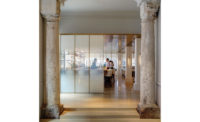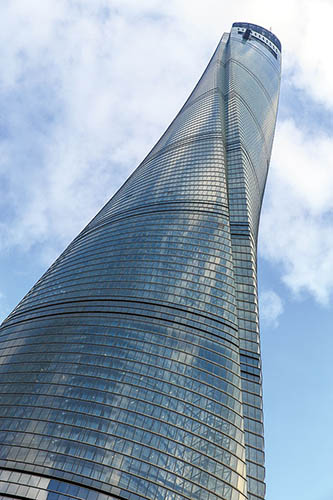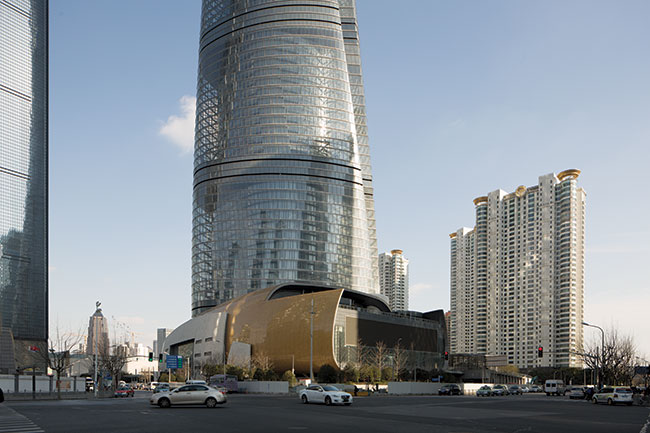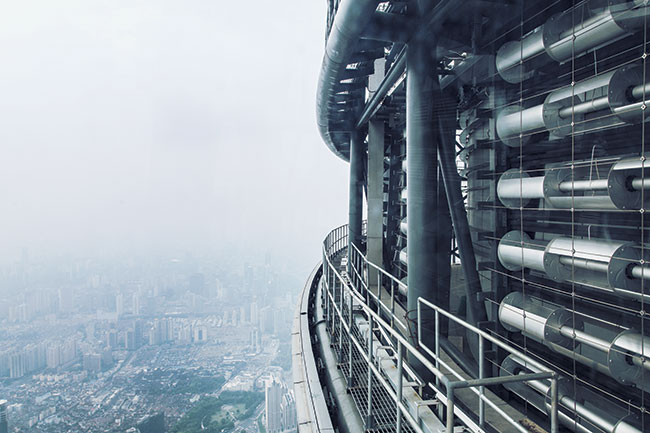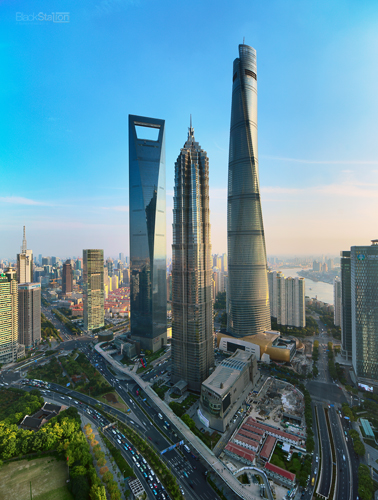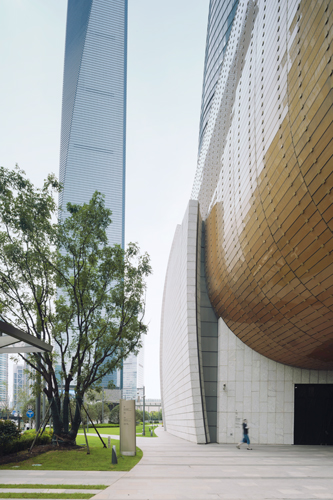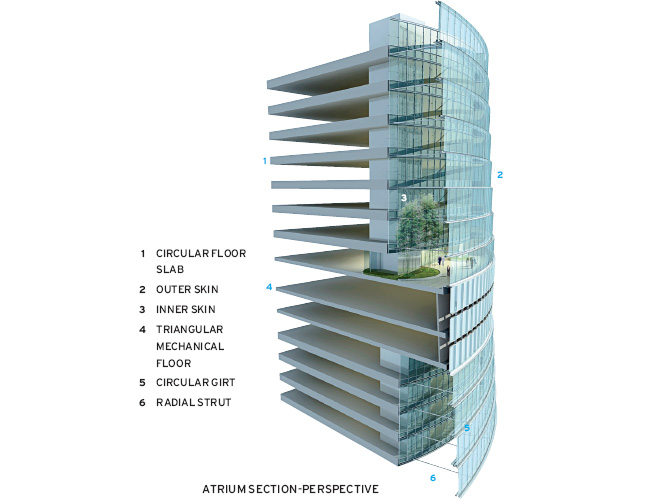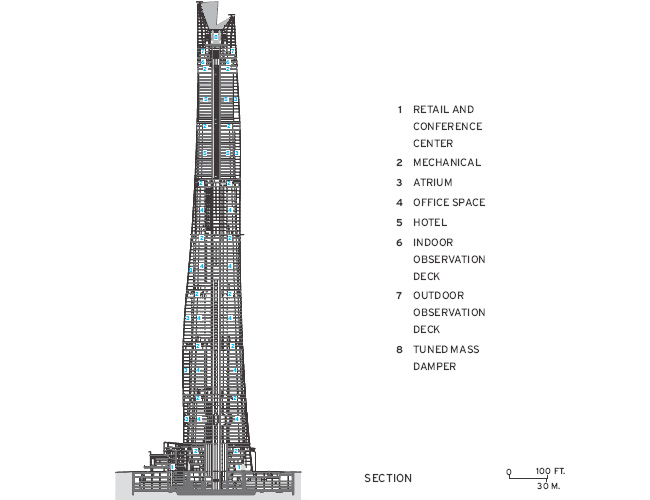Shanghai Tower
Twist and Shout: China's tallest building puts a new spin on high-rise design and asserts itself in a cluster of giants.
























Architects & Firms
Shanghai
In their race to the top, supertall buildings are always in competition with each other. At 2,717 feet, the Burj Khalifa in Dubai reigns supreme but will fall to second place when the 3,281-foot Kingdom Tower, now under construction in Jeddah, Saudi Arabia, is completed in 2018. Adrian Smith designed both buildings, the first while a design partner at Skidmore, Owings & Merrill (SOM) and the second while at Adrian Smith + Gordon Gill Architecture.
In Shanghai, a different kind of challenge has emerged as a trio of supertalls has risen during the past 16 years in Lujiazui, the booming financial core of the city’s Pudong district. Huddled close together, the three structures offer a lesson in recent high-rise design and demonstrate distinct approaches to grabbing attention on the skyline.
First out of the gate was SOM’s Jin Mao Tower, which rises to 1,381 feet as a glass-and-metal pagoda, a last gasp of postmodernism when it opened in 1999. Next door, Kohn Pedersen Fox sculpted a 1,615-foot-tall prism with a cutout at the top, turning its 2008 World Financial Center (WFC) into an elegant but cool abstraction that reminds some people of a giant bottle opener.
The last of the towering troika officially opens this fall even though few of its tenants will be moving in before next year. At 2,073 feet, the Shanghai Tower is the tallest building in China and the second-highest in the world. Designed by Gensler, with Tongji University’s Architectural Design & Research Institute as the local design institute, the building tapers and seems to wiggle as it rises—adding welcome animation to the Pudong cluster. The asymmetrical form evolved from the architects’ decision to organize the building as a set of nine zones or “neighborhoods” stacked on top of each other with gradually smaller diameters. After testing various geometries to reduce wind loads, the design team—including structural engineers at Thornton Thomasetti—carved the tower so it twists 120 degrees as it rises. A V-shaped indent called a strake soars up the side of the tower, further reducing the impact of winds and accentuating the twist in the form. According to Gensler, the building’s shape reduces wind loads by 24 percent compared with a standard rectangular tower, which allowed for a lighter structure and saved $58 million in materials.
The project team also wanted to make the building as environmentally responsible as possible, so it developed a double-skin design. Twenty-one atria act as climatic buffers between a cylindrical structure in the center, which contains all of the fully conditioned spaces, and an irregular outer glass envelope. The atria, ranging from 10 to 14 stories high, serve as “sky gardens” that spiral up as the tower rises. Near the top of the tower, 270 wind turbines have been installed in the facade to generate energy for powering exterior lighting. These strategies—along with sophisticated water-conservation practices, high-efficiency mechanical systems, landscaped areas covering one-third of the site, and extensive daylighting due to the clear glass—will reduce the building’s carbon footprint by 34,000 metric tons each year compared to conventional projects, according to Gensler.
To meet Chinese codes for tall buildings, the architects separated each “neighborhood” with a pair of stacked triangular-shaped floors—one for refuge in emergencies and the other for mechanical equipment—that extend beyond the cylindrical structure containing conditioned spaces (see drawing in Slide 11). Insulated glass units are attached to the circular floor slabs of the cylinder, while an outer skin of laminated glass within aluminum extrusions is suspended from large cantilevered trusses and stabilized by hoop rings and angled struts. The network of steel cables and supports allows the outer curtain wall to move independently of the rest of the building. The design team used parametric software to develop the complex system of more than 20,000 curtain wall panels—made of more than 7,000 unique shapes—and then employed lasers set at 30 locations in Pudong to precisely position all the panels.
The building’s structure is fairly conventional, relying on a concrete core surrounded by eight “super columns” made of steel on the inside and concrete on the outside. A 1,000-metric-ton tuned mass damper near the top of the tower counteracts swaying to make occupants more comfortable.
By sorting conference facilities, retail, offices, hotel, and an observation deck into separate stacked zones, the architects aim to create a “vertical urbanism,” says Dan Winey, a Gensler partner. “Shanghai is a city of small parks that help define neighborhoods,” says Jun Xia, a Gensler partner who grew up there. “We created the atria as interior parks and placed them vertically in the tower.” Each of the building’s nine zones provides about 400,000 square feet of space devoted mostly to one or two types of functions—retail and conference facilities at the bottom, offices in Zones 2 through 6, a hotel in Zones 7 and 8, and observation levels at the top. But the base of each atrium has restaurants and shops, so workers don’t need to leave the tower for lunch and overburden the elevator system. To whisk visitors to the observation deck on the 119th floor, the building has three express elevators that can go faster than 40 miles an hour, top in the world for speed. Eleven other elevators go 22 miles an hour, while 29 go 11 to 22 miles per hour.
In its effort to stand out from the more opaque or reflective buildings around it, the Shanghai Tower uses low-iron glass that expresses a sense of transparency from the outside. This clear glass also reduces the need for electric lighting inside the building, saving energy. During the day, and especially at night, pedestrians can see the Shanghai Tower’s key organizing elements, the atria, spiraling toward the sky. The glass wrapping serves as a “silk dress showing off the curves inside,” says Xia.
Shanghai lacks a main axis or street grid to stamp a strong organizing image in people’s minds. Instead, it has the Huangpu River, winding its way through the city and separating the new Pudong district on the east from the older Puxi on the west. The Shanghai Tower takes its cues from the river, using curves, not right angles, to imprint its form on the skyline. With its sheath of clear glass, the spiraling structure adds a softer, more sensual architectural note to those of its harder-edged neighbors. Smart and sexy, it does more than rise above the rest of the pack; its ambitious design and well-funded construction may serve as a final exclamation point to an era that saw China rise to the status of world power.
Size: 6.2 million square feet (4.1 million above grade; 2.1 million below grade)
Construction cost: $1.54 billion
Project cost: $2.2 billion
Completion date: December 2015
PeopleClient: Shanghai Tower Construction & Development Co., Ltd Owner: Shanghai Tower Construction & Development Co., Ltd.
Architect:
Personnel in architect's firm who should receive special credit: Architect of record: Architectural Design & Research Institute of Tongji University (Group) Co., Ltd. Interior designer: Gensler (Retail, Public Space)
Engineers:
MEP:
Wind Tunnel Testing:
Consultant(s):
Fire Protection and Life Safety:
Building Façade:
Landscape:
Lighting:
Acoustical:
Parking:
Energy Efficiency and Commissioning:
General contractor:
Steel Structure Construction:
Curtain Wall Contractor:
Photographer
Shen Zhonghai |
Products
Structural system
Manufacturer of any structural components unique to this project:
Exterior cladding Laminated glass panels on the exterior: Shanghai Yaohua Pilkington Glass Group Co., Ltd. Metal/glass curtain wall: Aurecon Engineer Consulting (Shanghai) Co., Ltd. Other cladding unique to this project: Stone cladding
Roofing
Glazing Skylights: Yes, in TMD Insulated-panel or plastic glazing: Both
Doors Metal doors: Steel fire-rate door Sliding doors: Glass Fire-control doors, security grilles: Metal security grilles
Hardware Closers: Dorma closers
Interior finishes Wall coverings: Kvadrat
Furnishings
Lighting Exterior: Pana LED
Conveyance Escalators: Schindler Accessibility provision: Fire lifts (Mitsubishi)
Other unique products that contribute to sustainability:
Add any additional building components or special equipment that made a significant contribution to this project: |


